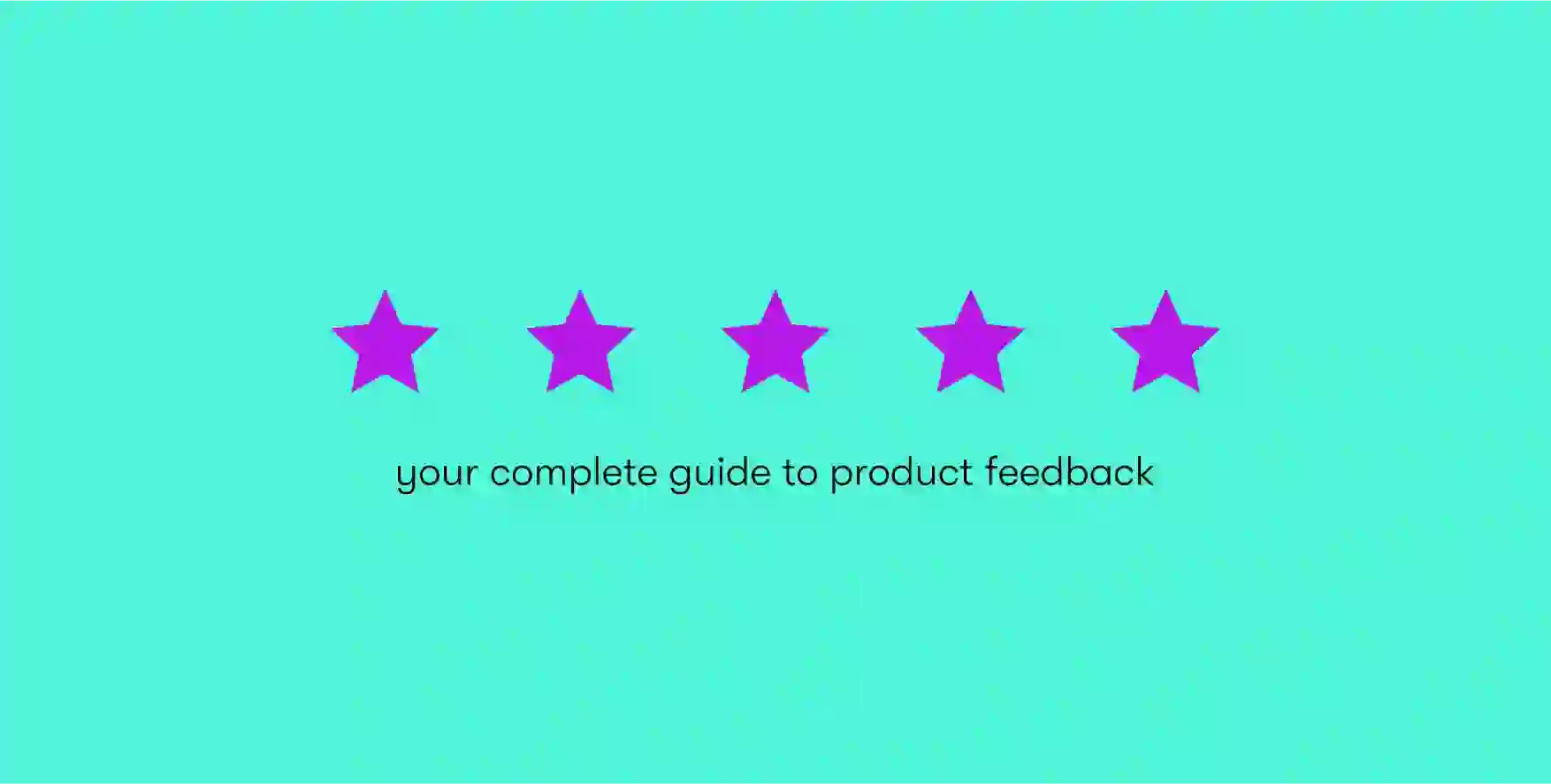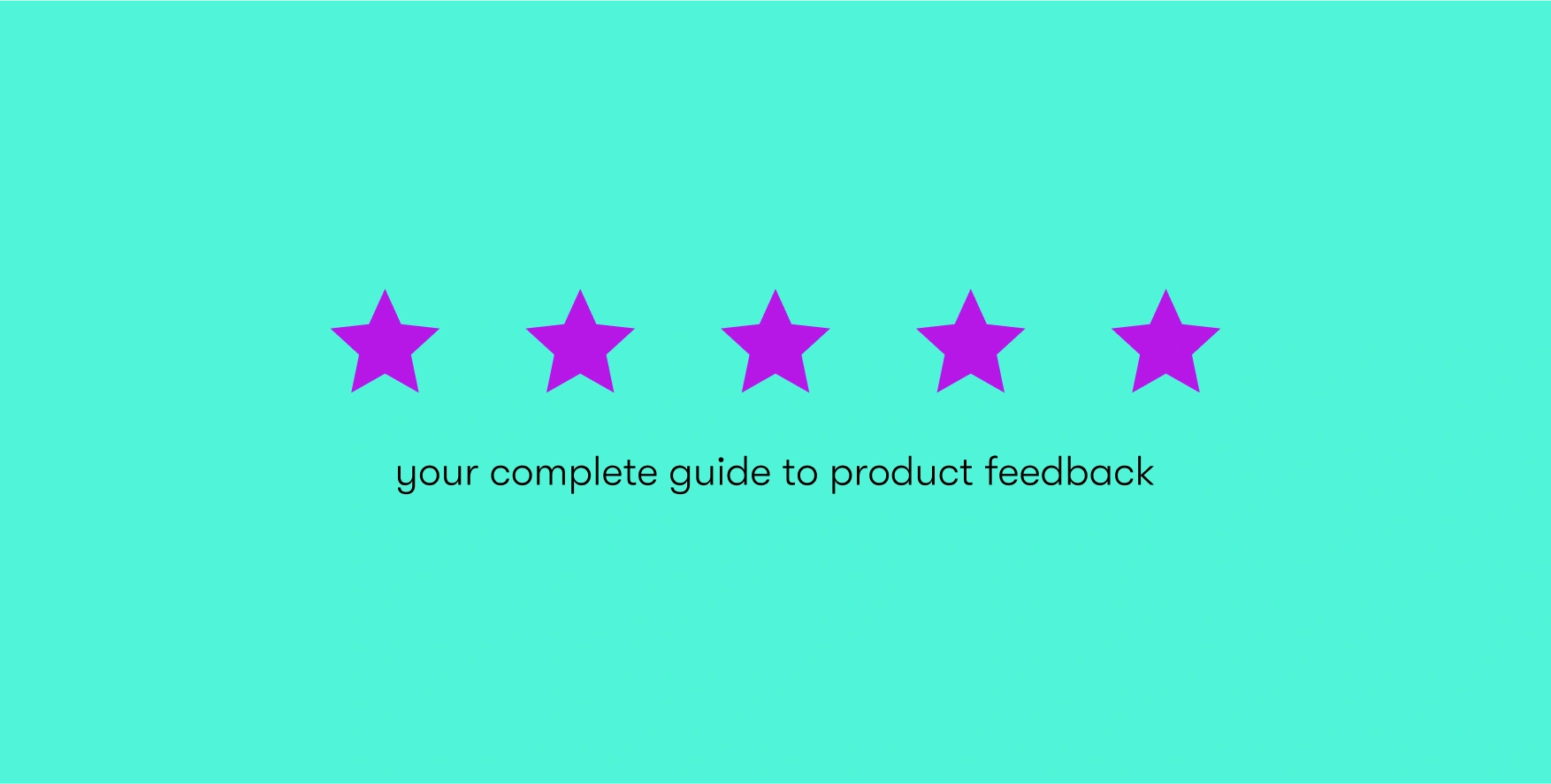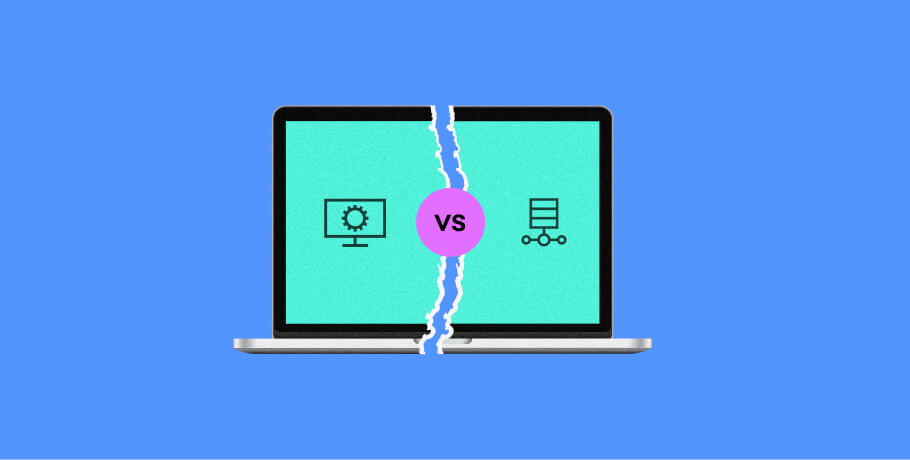With the right approach, product feedback can be used to grow every aspect of digital products. It results in more web traffic, positive customer experiences, and a greater return on investment.
However, without understanding that feedback, product managers might end up with mounds of worthless data. To truly use your user feedback effectively, you need to know how it works.
This article goes through the basics of product feedback, how to gain valuable data, and how to usefully implement the resulting customer insights.
What is product feedback?
Product feedback is user-based data that provides valuable insights into a specific product's customer journey and experience. It's used to identify pain points, potential improvements, and user satisfaction related to your product engineering practices.
Much like prototype testing, product feedback gathering is part of a complete feedback loop, which we will address in depth later in the article.
ready to build your dream career?
Don't wait any longer and pursue your dream career today. Send your CV and our team will match your skills with the best jobs at EPAM Anywhere.
What’s the difference between product feedback and customer feedback?
Not all feedback is product-centric. Sometimes, the more general category of customer feedback applies.
Feedback is more customer-centric when directed toward problems related to business. For example, if a customer shares a negative customer service experience, it might have nothing to do with the product experience per se.
Sometimes, when you collect customer feedback on purpose, this can lead to further information on user experience. Perhaps the person contacted your customer support service team to solve a problem with your product.
It's essential to separate the two feedback forms. You want your product direction to come from something other than customer conclusions that have nothing to do with the product.
To help with this, always be sure to analyze customer reviews with a discerning eye. Ask yourself if the customer is frustrated with the service, the company, or the product. By separating this data, you can make effective product development decisions.
What’s the difference between product feedback and market research?
It can also be challenging to separate market research and product feedback, especially after the product launch. Market research differs in that it focuses on the customer's needs for the general market in addition to the product-market fit rather than a direct experience with your product.
Crossover in market research and product feedback comes with competitors releasing similar products. Depending on company priorities, these products might have similar features but improve in different areas.
For example, BitWarden is a password manager with a unique feature: BitWarden Send. This feature lets users securely send files to each other, showing that users might demand more secure messaging from their password managers.
If yours is a password management company, you might find the feature's existence as proof that you need it for your product. However, it’s only product feedback if your feedback channel shows a trend of customers asking for this feature.
Your customers might have different priorities. In addition, emulating the direction of other companies makes you more of a follower than an innovator — you might take away from other improvement projects by implementing competitor features.
You can focus on initiatives that lean toward customer needs while aligning with your own customer goals to avoid this situation.
What are the types of product feedback?
In the examples above, we reference the two types of product feedback without naming them. Those two types of product feedback include the following:
- Solicited
- Unsolicited
Solicited feedback is the type you specifically ask for, while unsolicited feedback is the type you don't ask for.
A great example of solicited feedback is something that’s submitted via product feedback surveys. When you send customers an email-based survey, you’re explicitly asking them to share feedback. This "ask" is what makes it solicited.
Unsolicited feedback, by comparison, might be a community forum in your business field. For example, Nike might review Reddit boards about cool shoes to learn more about the customer experience with a new shoe release.
Why is it important to understand the different types of feedback? Because customers respond differently to those feedback situations.
How customers respond to solicited feedback
Customers might be less willing to share their negative experiences in solicited feedback. Some customers may stay positive if you offer discounts or incentives to encourage feedback.
Sometimes, the survey taker will skew their answers, assuming that positive responses will increase their reward odds. Moreover, even if you don't offer rewards, customers get tired of answering surveys, causing them to click through without properly considering their answers. Both situations can make the data less valuable.
By accounting for this error threshold in your data, you can still find value in solicited feedback.
How customers perform unsolicited feedback
Unsolicited feedback lets the customers express their opinions with no filter. Because a recent experience with the product often spurs feedback, the customer connects to that emotion.
Of course, with this feedback often being emotionally driven, the data might be something other than product-specific. For example, it might delve into feedback on business practices or poorly handled support tickets. This is still valuable feedback, but not for developing products.
Unsolicited feedback can also be questionable if you have a referral program. Any input that contains a referral link might not be helpful (especially if overly optimistic).
Understanding the motivation behind feedback is incredibly beneficial. When a product team decides the direction, this helps them make decisions based on a mix of customer experiences.
8 ways to collect product feedback
There are eight methods you can use to collect product feedback. They include the following:
- Surveys
- Social media
- Reviews
- Customer interviews
- Focus groups
- Analytics
- Social monitoring
- Product testing
Below, you'll find out more about the pros and cons of each method to gather feedback.
1. Customer surveys
A customer survey is one of the simplest and most identifiable forms of acquiring feedback. Using a survey, you can quickly gather essential data that can help drive product decision-making.
Surveys have been around for years, starting with direct-mail campaigns. As the internet grew, companies like SurveyMonkey popularized online surveys to get the same information.
The advancement of technology and product feedback tools specifically allows surveys to get data in seconds, making it a great way to gain information fast. You can also ensure that these surveys are sent to the correct respondents of your particular target audiences.
Some drawbacks come from survey bias, which comes in three forms:
- Sampling bias: When people are more likely to be chosen based on different factors (e.g. only getting data from people who live in one location).
- Response bias: When customers shift their responses based on different factors (e.g. feeling that they can't be overly negative).
- Non-response bias: When people included in the survey do not respond to it (or drop out if the survey goes through multiple stages).
2. Social media
Social media is a powerful tool for all kinds of businesses. People see it as a great way of communicating with these businesses in real time, often using it as an impromptu customer service line.
Twitter is full of business accounts that respond to customer inquiries often. Going to your favorite business and digging through their responses can reveal how to interact with customers.
Businesses can also use this feedback to identify common product issues. For example, if many customers complain about a new product feature, companies can use this data to pull the feature or address the problem temporarily.
Social media represents our need for instantaneous communication. You can manage these customer inquiries and gather information by assigning a dedicated social media manager.
3. Online reviews
Websites like Amazon and eBay provide us with a great example of how to use online reviews. They provide "social proof," encouraging buyers to decide based on other customer experiences.
These reviews fall into unsolicited and solicited use cases, as customers see themselves as "a helpful neighbor." This neighbor is eager and willing to share their experience, helping others to make more informed decisions.
Reviews provide a plethora of data on customer experiences. The data is also relatively easy to gather, as it can be found wherever you sell your products.
Online reviews can also be found on social media sites (such as Facebook), so gathering reviews from these sources can be a great way to improve products.
4. Direct user interviews
Direct customer interviews involve a one-on-one conversation with users. Some businesses call these "customer success calls," ensuring that the product meets (or exceeds) expectations.
These interviews are a different form of customer survey. As a result, the same biases mentioned earlier apply. However, there is a fourth bias worth noting: interviewer bias. This is when the interviewers have a biased position of the product, hooking onto any statements that stick to that bias.
Customer success calls can be constructive whenever the product is complex. For example, a B2B SaaS product that aids a client in managing their eCommerce store (like Shopify) can benefit from checking in with their premium customers.
These calls can help get feedback but are also excellent for customer retention. After all, speaking to someone means a customer can voice and solve the problem in the same call.
5. Focus groups
A focus group is a collection of customers gathered to gain many customer experiences in one interview. This form of product feedback is time-consuming and expensive but yields information you might not find elsewhere.
Because focus groups encourage conversation, individuals might have differing experiences. They can share those experiences, eliciting agreement or disagreement from fellow members.
This leads to problems that might be overlooked during a less intensive online survey. Discussion encourages conversation, which is why some meetings can be productive in generating ideas.
In contrast, these focus groups are a form of survey, meaning they run into the same potential biases as both phone and online surveys. There's also the additional risk of groupthink, where the entire group agrees with one person regardless of their differing experiences.
You can overcome these issues by performing interviews with different types of people. By identifying trends in multiple focus groups, you can better leverage their use.
6. Analytics data
Analytics includes any data set of customers that interact with your product. Popular examples of analytics include website visits, conversion rates (or purchases), and the number of return customers.
A good portion of analytics helps make marketing decisions. However, that data might have nothing to do with your product.
For product feedback, focus on these areas of analytics:
- Number of repeat purchases
- Number of returning site visitors
- Customer satisfaction data (rating your product on review sites)
- Sentiment analysis (finding positive or negative terms used in reviews)
- Keyword analytics (looking for specific keywords used throughout reviews)
- Classification/topic analytics (using AI-driven software to find out the context of the review content)
Some of these analytics areas rely on the use of technology. Examples of this can be found on Amazon, which identifies and sorts reviews based on keywords that customers use in their reviews.
However, without understanding the context, keywords can be unhelpful. Advanced analytics-gathering tools rely on sentiment and topic analytics, which apply context and emotion to the review. AI technology has improved the ability to take quantifiable data from open-ended answers.
7. Social monitoring
Social monitoring is when you monitor any product mentions for positive or negative results. This form of feedback collection is wholly unsolicited.
You can find these more indirect customer reviews on websites like Reddit or in Twitter threads. What differentiates social monitoring from direct social media and online reviews is that the data you gather isn't directed to the product's owner (you). Instead, it's a more general discussion about the product.
For example, a smartphone forum's participants might ask about the best camera. Customers can come onto this forum, suggesting your camera as the best option.
Because this is unsolicited and not directed at you, this form of feedback is entirely different from other forms. In many ways, the lack of pressure can create more honest answers.
Nonetheless, this is not to say that the user suggesting your product as a solution to the problem is entirely unbiased. For example, that user might be connected to your company or be part of your affiliate program without you knowing it. Be sure to keep this in mind when gathering social monitoring data.
8. Product beta testing groups
Beta testing is when customers test your product's features, considered part of a test phase. This provides valuable data before the official release date of a new product feature.
A company might choose to release the beta feature of their mobile app to a small group of customers or their entire user base. Either way, the beta aspect of it makes it less subject to the scrutiny of the overall product quality.
Companies can use data from the beta test to implement improvements before the feature's full release. This helps the customers feel more involved in the product roadmap.
Beta testing generally begins due to customer feedback gained in the earlier stages. For example, suppose your customer provides feedback that your eCommerce SaaS product lacks integrations with popular shipment management systems. In that case, you might develop a plugin to test before its full release.
These multiple stages create a great example of how a feedback loop works, which we will explore later.
What questions to ask in your product feedback
Here are a few questions you can ask as part of your product feedback:
- What feature do you like most about the product?
- What feature do you like the least?
- What features are missing?
- What do you not like about the product?
- How likely are you to use this product over alternatives?
- What problem(s) are you hoping to solve by purchasing our product?
- Does using the product help you solve this problem?
- How likely are you to recommend this product to a friend?
- How easy is the product to use?
- How would you feel if you could no longer use the product?
- How does the product make you feel?
- How would you improve the product?
Through primarily open-ended questions like the ones above, you'll better understand the customer experience.
To turn this qualitative feedback into quantitative feedback, you can have your customers answer on a scale of one to five or ten. Providing a value makes it easier to use the data, which is a feature included across many survey platforms.
Even so, you'll still want to provide customers with a means of giving open-ended feedback, as you might only get some critical data if all the questions are yes/no answers. People will offer more information if you give them full control over how they answer the question.
You'll also want to take care to avoid leading questions. For example, asking "How awesome do you think our product is?" implies that you want people to think of the product as excellent.
When is it best to ask for product feedback?
It's best to ask for product feedback after the customer has passed user onboarding and used a new product for some time. Typically, this timeframe is anywhere from one week to one month, depending on the complexity of the product.
When addressing long-term customers, ask for overall customer feedback twice a year. This checks in with customers using the product over a long period of time.
What strategic goals can you achieve with product feedback?
For many companies, the ultimate goal of product feedback is to design great products. This leads to a better customer experience, which (ideally) connects to more customer recommendations and sales.
In the case of public customer reviews and community discussions, recommendations of your product can lead to more sales. However, it's crucial to rely on something other than word-of-mouth feedback as the sole means to advertise products. Word-of-mouth advertising is great, but it could equally put off new customers rather than attract them.
Instead, the goal is to include the customer perspective as an essential part of the product improvement workflows, using your product as a field test of future products and new features.
Product feedback analysis: tips to execute improvement
Here, you'll find some quick tips you can use to improve your feedback management process:
- Set specific goals for your feedback-gathering process: Address needs related to new feature requests, market research findings, or overall customer experiences.
- Determine the type of data you need (specific to new features or an overall product perspective).
- Quantify your data with proven systems (like CSAT and NPS survey scores, which we will review later in this article).
- Group your feedback based on that data and other vital situations (like demographics data) to better consider biases and how different groups respond.
- Share customer feedback in discussions with your product team to get multiple perspectives on managing potential improvements.
- Implement changes based on priority (bug fixes and "customer-breaking" experiences come first, while other features might come later down the product development process).
- Review your product roadmap for potential improvements regularly to determine their necessity (which might change as customer expectations do).
- Create a process for following up with customers after changes are made to determine the effectiveness of those changes in a complete feedback loop.
How do you know if you have good product feedback?
You know you have good product feedback when it works to achieve company and feedback-related goals. A company's feedback-gathering process works to support the overall mission and focus of the company.
Customers feel appreciated when you hear their voices. To find this information, you can get feedback on your feedback processing. Asking customers if they feel valued and appreciated in another survey gives you a greater perspective.
Internally, you can apply this question to company initiatives. Ask questions like "Can we connect specific conclusions from the feedback loop to results in the company?" Follow-up questions and surveys can help discover this data.
Relying on sales data is an excellent way to gauge overall success. However, given the myriad of factors that can impact this data, you don't want to rely solely on it to draw conclusions in your feedback loop.
How to create a feedback loop
The feedback loop is your company's process of incorporating product feedback to ensure that your product growth is in a constant state of improvement.
Here's a framework of questions you might ask throughout your loop:
- What currently works with the product? What doesn't?
- What should we work on to improve the product? What feedback is the most important?
- What should our team know when implementing these changes?
- What part of our changes worked? What parts did not?
What makes this a loop is that it always returns to the first question: how does the product work (or not) in its current iteration?
A good product feedback loop aligns with customer needs by continuously improving and implementing new features. Applying it to your continuous improvement process ensures that you consider the customer's perspective.
How to analyze product feedback: common metrics
Below, you'll find some standard metrics that you can use across the product feedback spectrum. Consider how they differ in use:
- Net Promoter Score (NPS): A measurement of customer loyalty by asking people to rate their willingness to recommend you. The NPS score finds promoters (9 or 10), detractors (6 or lower), and passive customers (7 or 8), often based on a score out of 10.
- Customer Satisfaction Score (CSAT): An overall metric dictating how happy your customers are with you (product- or company-based). Much like the NPS, this is often done on a scale of 1-10.
- Customer Effort Score (CES): A good measure of product ease of use by asking customers how much effort they take to use your product. If customers feel that they need to put in more effort, they are more likely to find easier solutions elsewhere.
- Customer Health Score (CHS): A metric telling you whether your customers will stay with you or leave. It focuses on aspects like the amount of time they use the product for, the product type, and the number of customer service interactions they take.
- Customer Churn Rate (CCR): The percentage of customers lost to you overall. This isn't a specific metric to measure products but may link to other metrics (like the CES) with further data-gathering.
Other metrics, like the Customer Satisfaction Survey (CSS), might also be included here. However, it's essential to differentiate between customer service and product issues.
Key takeaways
Good product feedback is a crucial part of your process. It all connects into part of a product feedback loop, and into part of a larger-scale effort to improve the product and put the company in a better strategic position.
You take a step in the right direction by treating your product like it’s in a constant "field test" state. You should always take steps to improve the product, especially during earlier stages of the product lifecycle.
You can do this with greater effectiveness by differentiating between different types of feedback, deciding how to gather data, and understanding the limitations of this data. With these tips, we hope your product becomes the best version of itself, ultimately helping your business to grow.

The EPAM Anywhere Editorial Team is an international collective of senior software engineers, managers and communications professionals who create, review and share their insights on technology, career, remote work, and the daily life here at Anywhere.
The EPAM Anywhere Editorial Team is an international collective of senior software engineers, managers and communications professionals who create, review and share their insights on technology, career, remote work, and the daily life here at Anywhere.
Explore our Editorial Policy to learn more about our standards for content creation.
read more

















